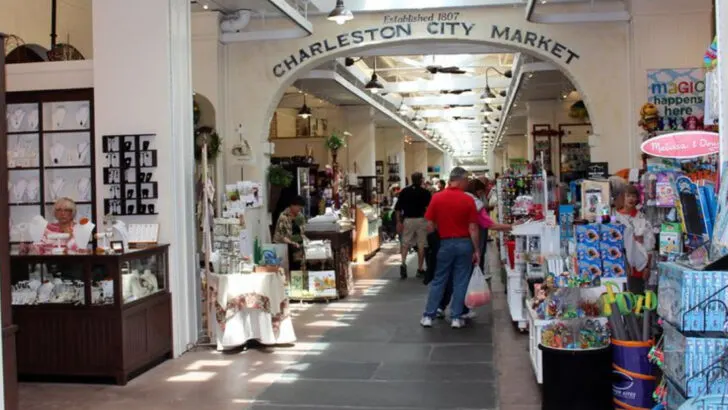The truth is hard to ignore—Charleston is slowly losing the very magic that made it irresistible. The pastel-painted houses, moss-draped oaks, and cobblestone streets once whispered stories of history. Today, those same streets are crowded with lines of tour buses, souvenir shops, and streams of visitors jostling for the same photo of Rainbow Row. What was once a graceful Southern city now feels like it’s buckling under the pressure of being everyone’s favorite getaway. Locals grumble about skyrocketing rents and restaurants swapping tradition for trendiness. The quiet corners that once felt like secret treasures are now packed with selfie sticks and bar crawls. Even the soft hush of the harbor seems drowned out by the constant hum of tourism. Charleston hasn’t lost its beauty—but its soul feels fragile. The question is: how much longer can its historic charm withstand the weight of endless crowds before it disappears completely?
Overcrowded Streets, Overwhelmed Locals
Charleston’s narrow historic streets weren’t designed for the tens of thousands of daily visitors. Once quaint alleys now feel like packed amusement parks. Frustrated residents find it difficult to move through the crowded streets, which dilutes the peaceful atmosphere the city was known for. The inundation of tourists changes the dynamic, transforming the historic tranquility into a bustling, chaotic environment. Visitors eager to explore the charm find themselves in long queues, and the serene Southern pace is replaced with rushed movements. This overwhelming influx challenges the locals’ daily lives and the city’s operational capacity.
Short-Term Rentals Replacing Historic Homes
Entire neighborhoods in Charleston are being bought out and turned into Airbnbs. What were once lived-in historic homes with generational roots are now revolving doors for weekend travelers. This turnover erases the residential soul of the city, replacing local families with transient guests. The sense of community is fading, as short-term rentals dominate. Historic charm is being replaced with commercial opportunism, altering the city’s character. Residents lament the loss of neighborhood bonds and lament the transformation of personal homes into mere accommodations. This shift signifies a broader trend impacting the city’s cultural fabric and continuity.
Cruise Ship Invasions
Large cruise ships dump thousands of tourists at a time into Charleston’s historic district. Their sudden arrival overwhelms local infrastructure and strips the city of its laid-back pace. The waterfront becomes a transit zone, crowded and bustling, rather than a tranquil escape. The sheer number of tourists challenges the city’s resources, leading to congestion and noise. Residents and shop owners struggle with the sudden influx, disrupting daily routines and peaceful atmospheres. The charm of the coastal city is compromised by the industrial scale of cruise tourism, highlighting the need for balanced visitor management strategies.
Skyrocketing Cost of Living
Tourism demand has inflated real estate prices and rent in Charleston, forcing long-time locals out. As boutique hotels and luxury rentals take over, the city is slowly becoming a playground for the wealthy rather than a home for its original residents. Historic neighborhoods see a shift from local-focused living to tourist-centric amenities. This economic pressure alters community demographics, driving away those who maintain the city’s cultural heritage. The locals who once defined Charleston’s unique character are displaced, leaving behind a city that caters more to visitors than its own people.
Commercialization of Culture
The Gullah traditions, Southern folklore, and Charleston’s deep-rooted Black history are being packaged and sold in tourist-friendly formats. Often marketed by those with little connection to the culture, authenticity is reduced to spectacle. This commercialization strips cultural expressions of depth, transforming them into shallow attractions. Visitors consume cultural snippets without context, overlooking the richness of Charleston’s heritage. Such practices dilute the integrity of cultural narratives, turning vibrant traditions into mere entertainment. The city’s cultural landscape shifts towards quick consumption, risking the erasure of nuanced histories and lived experiences.
Vanishing Mom-and-Pop Shops
Independent bookshops, bakeries, and local artisans in Charleston are losing ground to souvenir stores and chain restaurants. This shift erodes the city’s identity, making it feel more like any other tourist hub than a one-of-a-kind Southern treasure. Long-standing businesses that provided unique, personalized experiences are being replaced with generic alternatives. The charm of Charleston’s local commerce is fading, as economic pressures favor larger, tourist-focused enterprises. This commercial transformation affects the cityscape and social interactions, diminishing the vibrancy of Charleston’s small business community and its historical character.
Overuse of Historic Landmarks
Iconic sites like Rainbow Row, The Battery, and Magnolia Plantation face constant foot traffic and selfie-hungry crowds. Preservation efforts are strained as these landmarks endure wear and tear from excessive use. The once-still beauty of these spaces is interrupted by noise and crowds, challenging conservation initiatives. Tourists eager for photos contribute to environmental degradation, compromising the integrity of cherished historic sites. The balance between accessibility and preservation is tested as the city’s rich history risks being overshadowed by contemporary demands for tourist engagements and entertainment.
Traffic Congestion and Parking Nightmares
With more visitors than ever, driving and parking in Charleston’s historic district has become a daily battle. Constant congestion disrupts the neighborhood feel and makes even basic errands a logistical headache for locals. Streets once known for their charm are now packed with vehicles, creating an environment of frustration and delay. Residents find it increasingly difficult to navigate their own city, as parking spaces are scarce. The spontaneous beauty of exploring Charleston is marred by traffic woes, affecting both locals and tourists alike, and urging a reevaluation of transportation management.
Loss of Authentic Experiences
Guided tours in Charleston are being watered down to accommodate large groups, cutting nuance and history in favor of digestible soundbites. Visitors may get a good photo, but they leave without truly understanding Charleston’s layered story. This simplification caters to quick consumption, sacrificing depth for accessibility. Authentic experiences that once offered insights into Charleston’s rich history are now reduced to surface-level narratives. This shift alters the tourist experience, distancing visitors from genuine cultural engagement. The city’s educational potential is diminished, risking the loss of thoughtful storytelling and cultural appreciation.
Cultural Dilution Through “Instagramification”
Landmarks in Charleston are being styled and altered to cater to aesthetics rather than history. Murals, props, and pop-up installations encourage photo ops over education, shifting focus from preservation to performance. This trend prioritizes visual appeal at the expense of historical integrity. Visitors are drawn to instagrammable moments, often overlooking the deeper significance of the sites. The city’s rich heritage risks being overshadowed by transient trends, leading to cultural dilution. Such changes challenge preservation efforts, as the emphasis on superficial beauty can detract from meaningful historical engagement.

